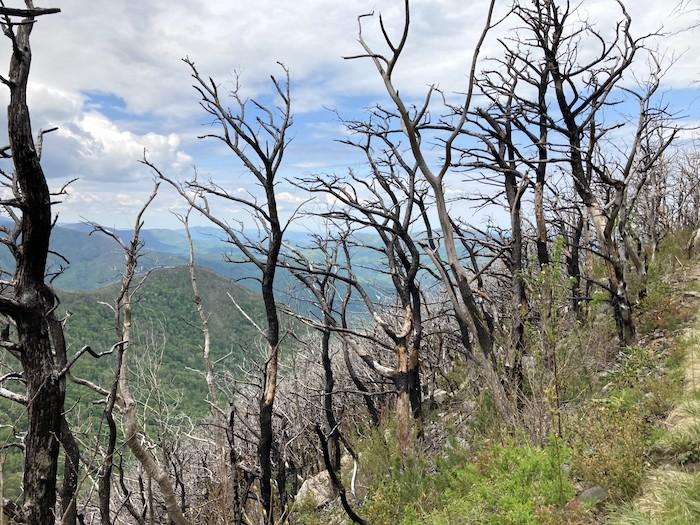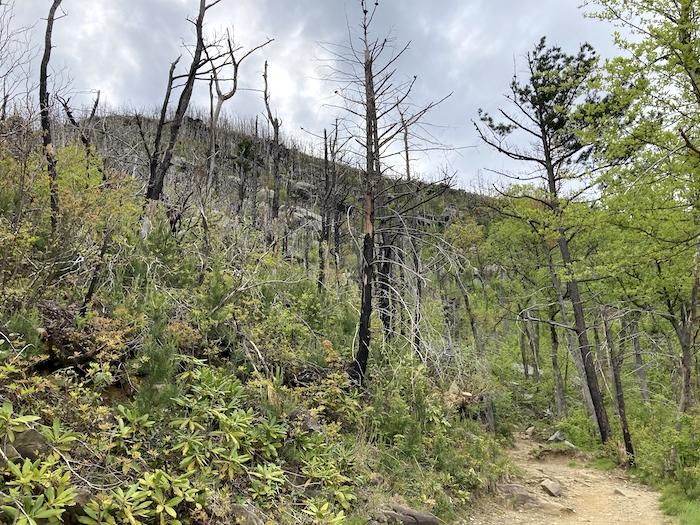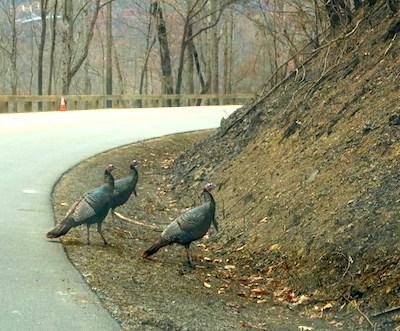How Fire Left Its Mark on the Smoky Mountain Landscape
A Five-Year Reflection
By Kylie Wolfe
Fire is an unrelenting force. When controlled, it represents strength and power. When wild, it leaves behind visible scars. The latter is what the Great Smoky Mountains National Park landscape and community witnessed in recent years. Time provides space to heal, but despite nature’s attempts to renew, tangible evidence of tragedy remains.
Five years ago, the Chimney Tops 2 fire ravaged approximately 11,000 acres of the park’s wooded landscape. It spilled out of the park and pulled the town of Gatlinburg into its grasp. Fourteen people died and approximately 2,500 homes and buildings were either destroyed or damaged outside park boundaries. Several lawsuits blame the National Park Service for poorly managing and monitoring the fire when conditions were ripe for it to spread. In December 2020, a judge ruled that the NPS failed to warn nearby residents of this imminent threat and refused to dismiss those cases. The matter remains pending as of this article.
In May, my fiancé and I traveled to Great Smoky to hike Mount LeConte, the park’s third-highest peak, and stay at the LeConte Lodge, a series of rustic cabins constructed in 1926. At first, our surroundings appeared beautifully undisturbed, but as our shoes crunched fine gravel and traversed uneven rocks along the Rainbow Falls Trail, signs of the wildfire came into view.

Blackened trees line the upper section of the Rainbow Falls Trail/Kylie Wolfe
After we reached the trail’s namesake, an 80-foot waterfall, we approached an exposed section warmed by the Tennessee summer sun. Surrounded by burnt trees, we were standing right where the flames of the largest fire in Great Smoky Mountains National Park history once blazed. Stunted trees, shadows of their former selves, maintained a darkened outer layer. Below those blackened skeletons, hundreds of healthy plants had erupted from the soil. Shades of green contrasted the charred remnants above as leafless, frail branches protruded in all directions.
“A lot of people think that when a fire burns across a landscape and it kills all the trees, they’re destroyed and everything's dead. But in fact, especially in the southeastern United States, there’s a riot of regeneration that occurs almost immediately,” said Rob Klein, fire ecologist for the NPS.
In moderation, fire protects landscapes from accumulating flammable underbrush and housing invasive plant species. It gives the forest a chance to reset and breathe, returning nutrients into the soil. In excess, fire disrupts natural timelines and limits the potential for biodiversity. That’s what we’re experiencing today as climate change fuels a growing number of unusually intense wildfires across the country. Warmer air, drier kindling, and summer drought are encouraging fires to spread quickly and burn at times with unpredictable fury.
Klein explained that the Chimney Tops 2 fire consumed almost all fuel on the ground. During a prescribed burn, an intentionally set yet controlled fire used for land management, Klein and his team reduce fuel loads by only 20 to 30 percent. The right conditions for fire made the 2016 flames hard to stop.
“When we see conditions stacking up that are similar to the conditions we saw when [the 2016] fire occurred, that's going to cause us to respond differently than we did in the past,” he said.

The forest burned by the Chimney Tops 2 Fire is slowly recovering/Kylie Wolfe
Whenever possible, the NPS lets regeneration occur naturally. To help guide the restoration of the areas damaged in 2016, crews removed invasive plant species that sprouted in the absence of the park’s native plants. Following a disturbance event, invasive species seize the opportunity to grow without competition. Their seeds are often transported by wind, animals, and can even arrive on firefighters' clothes and equipment. Garlic mustard (Alliaria petiolata), an odorous, green-leafed plant with white flowers, is one that crews choose to remove manually. A team of experts in soil science, hydrology, and modeling also assessed erosion, flood, and landslide risk. No notable wildfire-related floods or erosion events occurred.
“There are certain forest types, especially forest types dominated by pine and oak, that are dependent on fire,” said Klein. “And the species that occupy those forest communities are also dependent on that disturbance.”
With more than 19,000 species identified and documented, the park that lays rumpled along the mountainous Tennessee-North Carolina border is considered the country’s most biodiverse park. At least a dozen of its flora and fauna species benefit from regular fires. Immediately after Chimney Tops 2, wild turkeys were seen scratching for food in the soil. Since, black bear, white-tailed deer, and other mammals have returned to source acorns from the regenerating forest. Ash acting as fertilizer has also prompted the regrowth of mountain laurel (Kalmia latifolia) and jewelweed (Impatiens capensis) in burned areas. Most notably, the fire prompted the resin-sealed cones of Table Mountain pine (Pinus pungens) trees to open and release seeds.

Turkeys returned to the landscape after the fire was out/NPS file
“Days after the fire, several of us walked up one of the trails where there was a particularly large Table Mountain pine stand,” said Klein. “As we stood there, we started to notice things fluttering through the air. When we followed one of them to the ground, it was a Table Mountain pine seed coming out of a freshly opened cone. They were falling across the landscape.” He compared the seeds to tiny helicopters.
Following the 2016 fire, Klein and his team also visited the site of the Hickory fire, a wildfire that occurred near Cades Cove, the iconic valley on the park’s west side, in 1986. Both fires burned through a similar type of vegetation under comparable drought conditions. Where the Hickory fire burned, the team found an impenetrable wall of 20- to 25-foot-tall Table Mountain pine. Klein expects the nearly ten-foot-tall saplings along the Chimney Tops 2 fire’s path to look similar in 30 years.
“It's clear, five years later, that [some areas of the park] are going to become pine forest again — it's just a matter of time,” said Klein.
Half a decade removed, what had been lost to the Chimney Tops 2 flames is coming back to life: The forest floor blooming again beneath dense thickets of pine and oak. Even though the flames of the fire were uncontrolled, the flora and fauna are regaining control of their future.

Sunrise from Myrtle Point/Kylie Wolfe
When my fiancé and I reached our destination, six-and-a-half miles up the trail, we settled amidst the warm glow of the lodge’s old-timey kerosene lamp. The next morning, we hiked almost three-quarters of a mile to Myrtle Point, a coveted sunrise spot. Unobstructed, our view changed by the minute as streaks of orange and yellow filled the morning sky. The sun crested the tree-lined mountain tops marking the start of a new day. Nature had prevailed and, with time, the Smoky Mountain community can find hope in the surrounding landscape.

 Support Essential Coverage of Essential Places
Support Essential Coverage of Essential Places
Comments
A very introspective look at the 'after' of fires. We get so caught up in fires when they're burning, but to hear an account of the regrowth and challenges that burned areas face is very interesting.